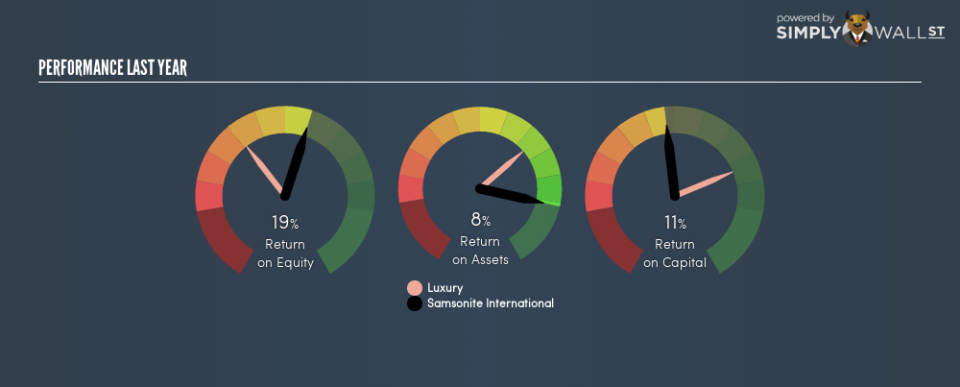Here’s why Samsonite International S.A.’s (HKG:1910) Returns On Capital Matters So Much

Today we’ll evaluate Samsonite International S.A. (HKG:1910) to determine whether it could have potential as an investment idea. Specifically, we’ll consider its Return On Capital Employed (ROCE), since that will give us an insight into how efficiently the business can generate profits from the capital it requires.
First, we’ll go over how we calculate ROCE. Next, we’ll compare it to others in its industry. Last but not least, we’ll look at what impact its current liabilities have on its ROCE.
Understanding Return On Capital Employed (ROCE)
ROCE measures the amount of pre-tax profits a company can generate from the capital employed in its business. Generally speaking a higher ROCE is better. In brief, it is a useful tool, but it is not without drawbacks. Renowned investment researcher Michael Mauboussin has suggested that a high ROCE can indicate that ‘one dollar invested in the company generates value of more than one dollar’.
How Do You Calculate Return On Capital Employed?
Analysts use this formula to calculate return on capital employed:
Return on Capital Employed = Earnings Before Interest and Tax (EBIT) ÷ (Total Assets – Current Liabilities)
Or for Samsonite International:
0.11 = US$443m ÷ (US$5.1b – US$953m) (Based on the trailing twelve months to September 2018.)
Therefore, Samsonite International has an ROCE of 11%.
See our latest analysis for Samsonite International
Want to help shape the future of investing tools and platforms? Take the survey and be part of one of the most advanced studies of stock market investors to date.
Does Samsonite International Have A Good ROCE?
ROCE is commonly used for comparing the performance of similar businesses. We can see Samsonite International’s ROCE is around the 9.4% average reported by the Luxury industry. Separate from Samsonite International’s performance relative to its industry, its ROCE in absolute terms looks satisfactory, and it may be worth researching in more depth.
As we can see, Samsonite International currently has an ROCE of 11%, less than the 20% it reported 3 years ago. So investors might consider if it has had issues recently.
Remember that this metric is backwards looking – it shows what has happened in the past, and does not accurately predict the future. Companies in cyclical industries can be difficult to understand using ROCE, as returns typically look high during boom times, and low during busts. ROCE is only a point-in-time measure. What happens in the future is pretty important for investors, so we have prepared a free report on analyst forecasts for Samsonite International.
Do Samsonite International’s Current Liabilities Skew Its ROCE?
Current liabilities include invoices, such as supplier payments, short-term debt, or a tax bill, that need to be paid within 12 months. Due to the way the ROCE equation works, having large bills due in the near term can make it look as though a company has less capital employed, and thus a higher ROCE than usual. To check the impact of this, we calculate if a company has high current liabilities relative to its total assets.
Samsonite International has total liabilities of US$953m and total assets of US$5.1b. As a result, its current liabilities are equal to approximately 19% of its total assets. Current liabilities are minimal, limiting the impact on ROCE.
The Bottom Line On Samsonite International’s ROCE
Overall, Samsonite International has a decent ROCE and could be worthy of further research. Of course, you might find a fantastic investment by looking at a few good candidates. So take a peek at this free list of companies with modest (or no) debt, trading on a P/E below 20.
For those who like to find winning investments this free list of growing companies with recent insider purchasing, could be just the ticket.
To help readers see past the short term volatility of the financial market, we aim to bring you a long-term focused research analysis purely driven by fundamental data. Note that our analysis does not factor in the latest price-sensitive company announcements.
The author is an independent contributor and at the time of publication had no position in the stocks mentioned. For errors that warrant correction please contact the editor at editorial-team@simplywallst.com.

